Comprehensive Marketing Plan for Red Bull: A Detailed Analysis
VerifiedAdded on 2023/06/10
|19
|4872
|50
Report
AI Summary
This report provides a comprehensive marketing plan for Red Bull, analyzing how the company creates customer value through its marketing objectives and strategies. It discusses the issues Red Bull faces in attracting a broader customer base due to health concerns and pricing. The report includes an STP (Segmentation, Targeting, and Positioning) analysis, detailing Red Bull's target demographics and geographic focus, as well as a threats and opportunities analysis, highlighting competition and emerging markets. The marketing strategy covers product mix, pricing, distribution, and promotion. The action program, budget, and controls for monitoring progress are also outlined. The report concludes by summarizing the key findings and recommendations for Red Bull to enhance its marketing effectiveness and market share. Desklib offers more solved assignments and past papers for students.
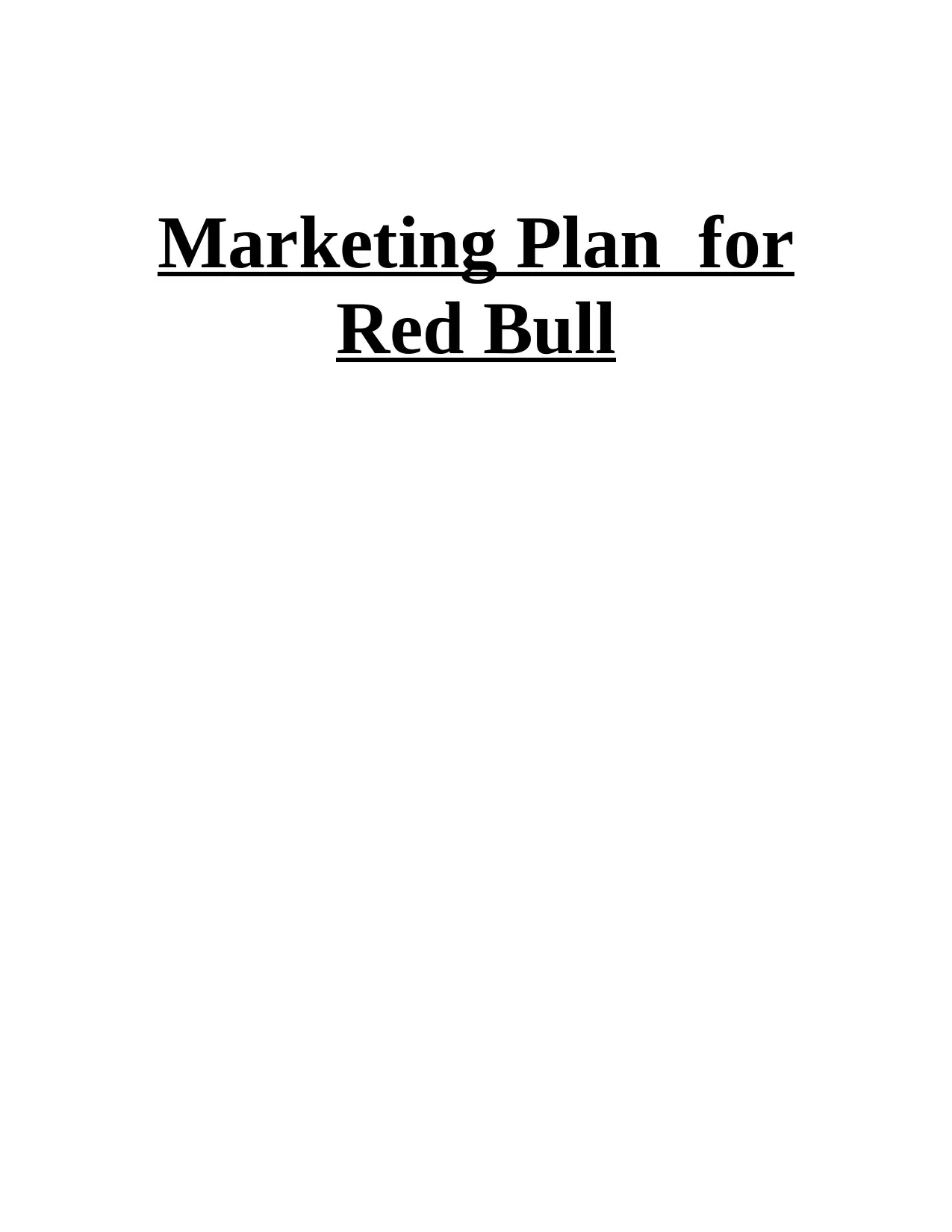
Marketing Plan for
Red Bull
Red Bull
Paraphrase This Document
Need a fresh take? Get an instant paraphrase of this document with our AI Paraphraser
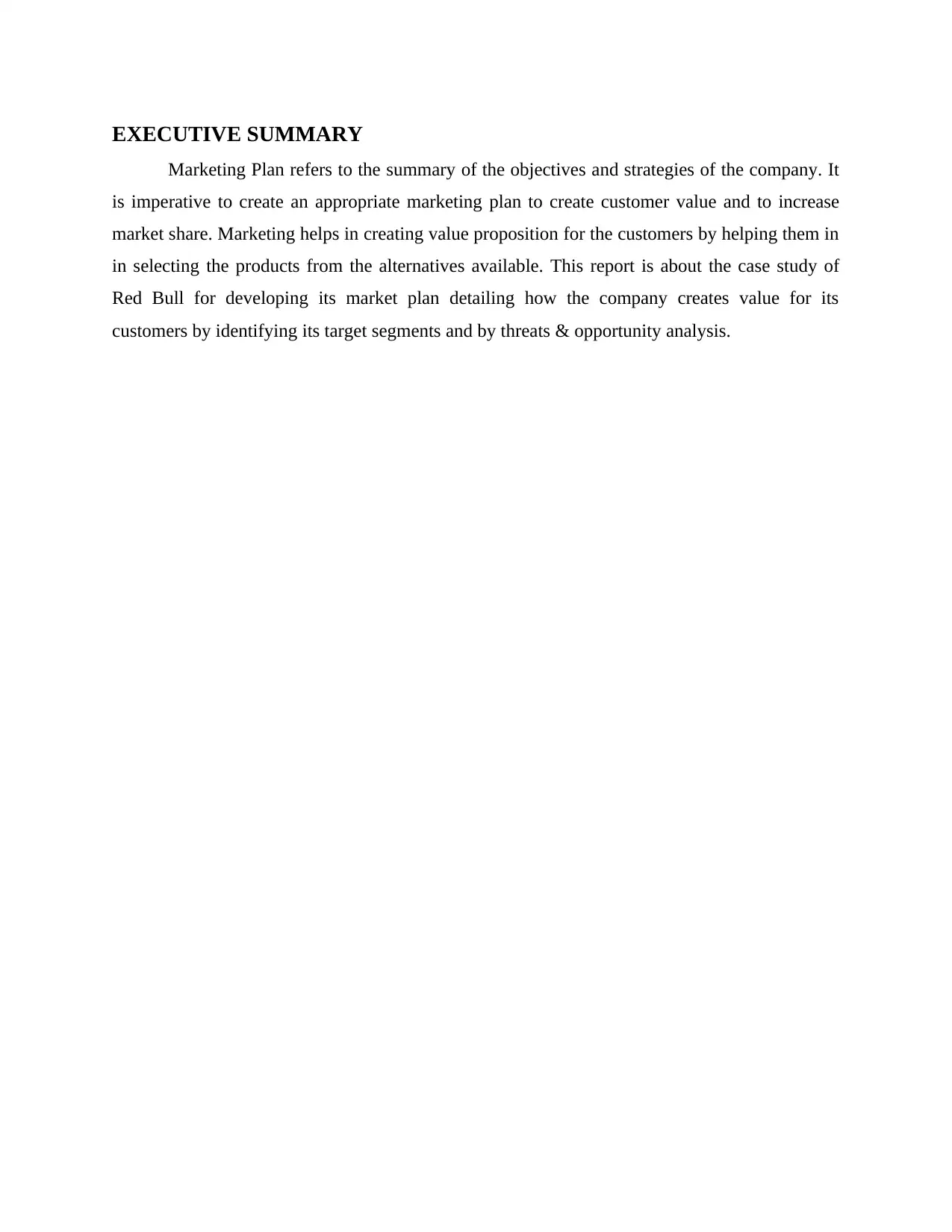
EXECUTIVE SUMMARY
Marketing Plan refers to the summary of the objectives and strategies of the company. It
is imperative to create an appropriate marketing plan to create customer value and to increase
market share. Marketing helps in creating value proposition for the customers by helping them in
in selecting the products from the alternatives available. This report is about the case study of
Red Bull for developing its market plan detailing how the company creates value for its
customers by identifying its target segments and by threats & opportunity analysis.
Marketing Plan refers to the summary of the objectives and strategies of the company. It
is imperative to create an appropriate marketing plan to create customer value and to increase
market share. Marketing helps in creating value proposition for the customers by helping them in
in selecting the products from the alternatives available. This report is about the case study of
Red Bull for developing its market plan detailing how the company creates value for its
customers by identifying its target segments and by threats & opportunity analysis.
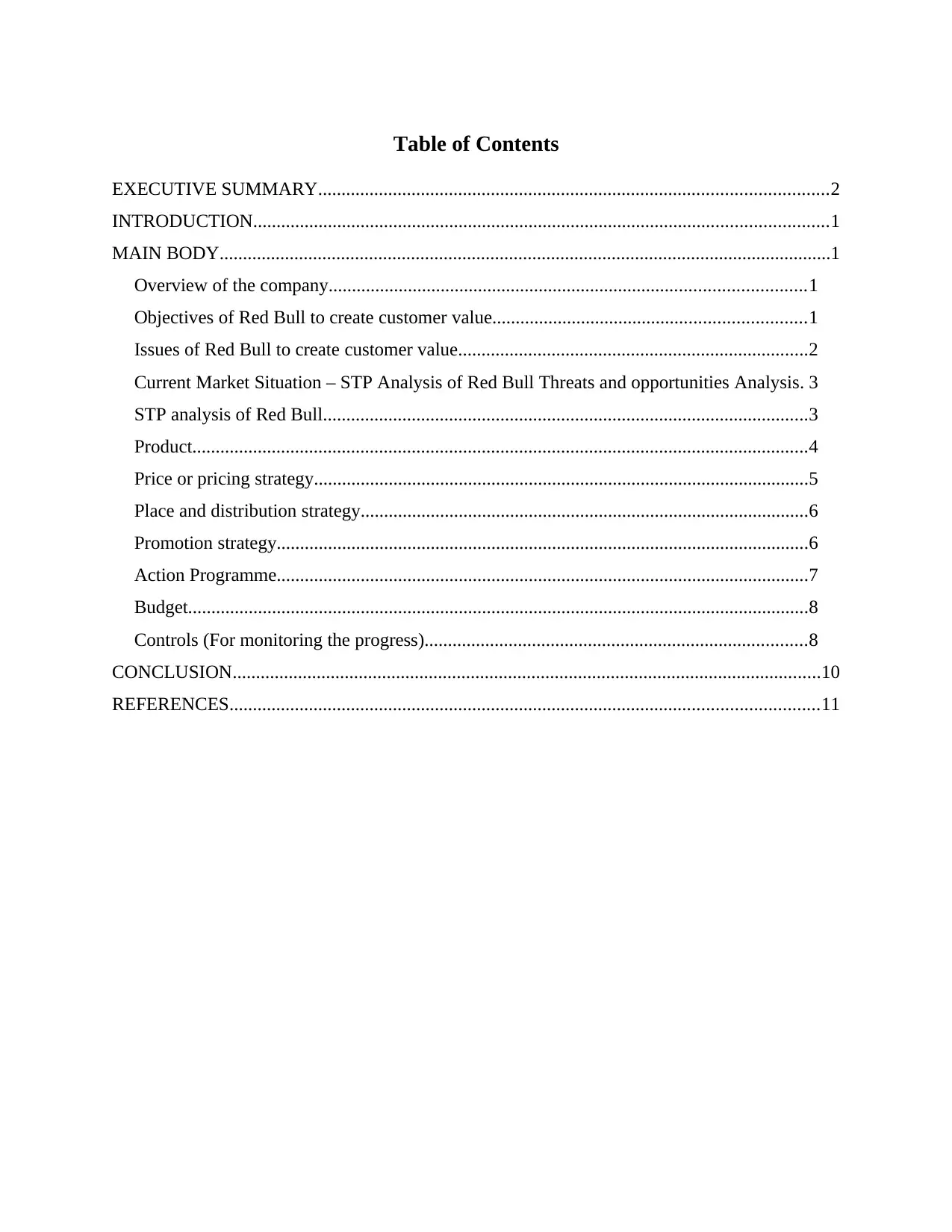
Table of Contents
EXECUTIVE SUMMARY.............................................................................................................2
INTRODUCTION...........................................................................................................................1
MAIN BODY...................................................................................................................................1
Overview of the company......................................................................................................1
Objectives of Red Bull to create customer value...................................................................1
Issues of Red Bull to create customer value...........................................................................2
Current Market Situation – STP Analysis of Red Bull Threats and opportunities Analysis. 3
STP analysis of Red Bull........................................................................................................3
Product....................................................................................................................................4
Price or pricing strategy..........................................................................................................5
Place and distribution strategy................................................................................................6
Promotion strategy..................................................................................................................6
Action Programme..................................................................................................................7
Budget.....................................................................................................................................8
Controls (For monitoring the progress)..................................................................................8
CONCLUSION..............................................................................................................................10
REFERENCES..............................................................................................................................11
EXECUTIVE SUMMARY.............................................................................................................2
INTRODUCTION...........................................................................................................................1
MAIN BODY...................................................................................................................................1
Overview of the company......................................................................................................1
Objectives of Red Bull to create customer value...................................................................1
Issues of Red Bull to create customer value...........................................................................2
Current Market Situation – STP Analysis of Red Bull Threats and opportunities Analysis. 3
STP analysis of Red Bull........................................................................................................3
Product....................................................................................................................................4
Price or pricing strategy..........................................................................................................5
Place and distribution strategy................................................................................................6
Promotion strategy..................................................................................................................6
Action Programme..................................................................................................................7
Budget.....................................................................................................................................8
Controls (For monitoring the progress)..................................................................................8
CONCLUSION..............................................................................................................................10
REFERENCES..............................................................................................................................11
⊘ This is a preview!⊘
Do you want full access?
Subscribe today to unlock all pages.

Trusted by 1+ million students worldwide
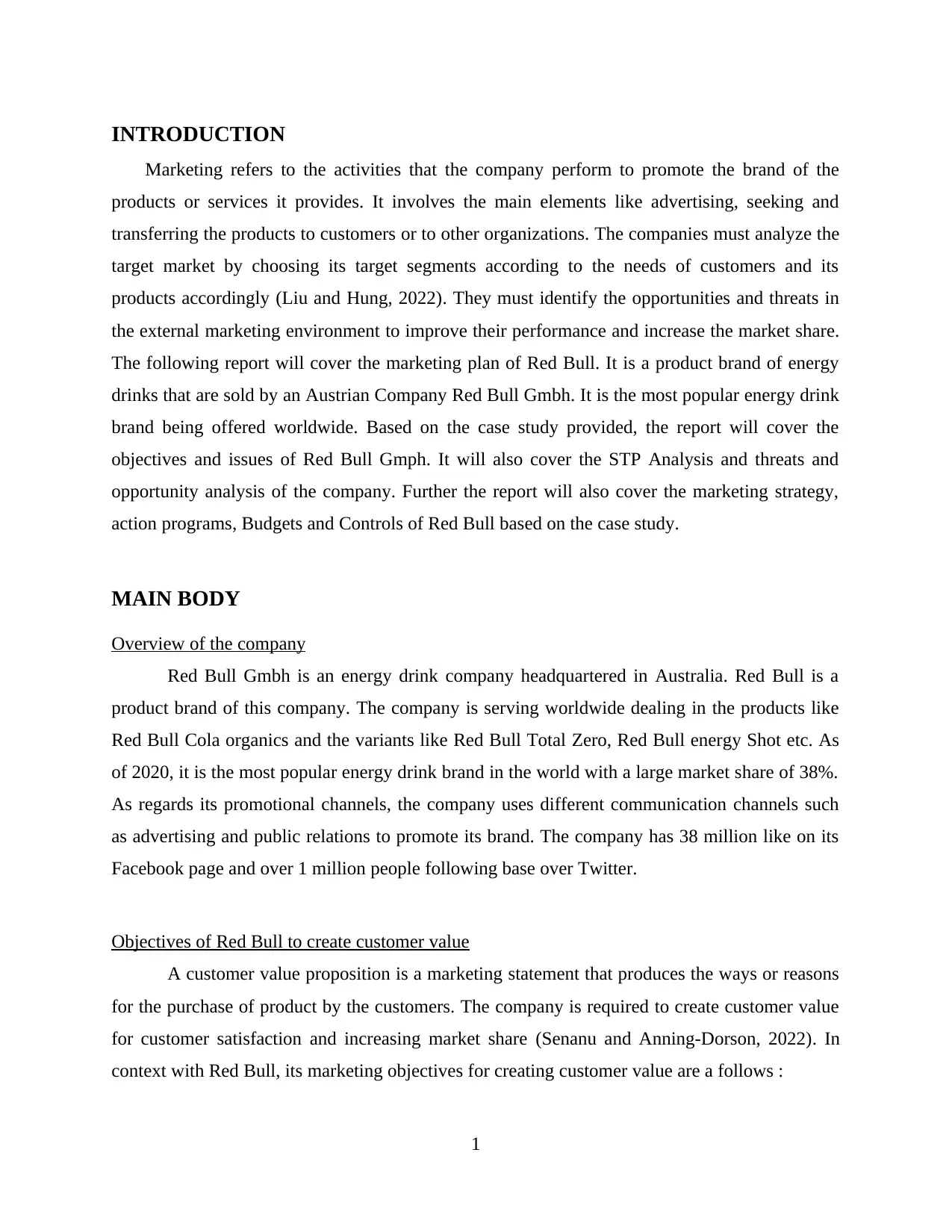
INTRODUCTION
Marketing refers to the activities that the company perform to promote the brand of the
products or services it provides. It involves the main elements like advertising, seeking and
transferring the products to customers or to other organizations. The companies must analyze the
target market by choosing its target segments according to the needs of customers and its
products accordingly (Liu and Hung, 2022). They must identify the opportunities and threats in
the external marketing environment to improve their performance and increase the market share.
The following report will cover the marketing plan of Red Bull. It is a product brand of energy
drinks that are sold by an Austrian Company Red Bull Gmbh. It is the most popular energy drink
brand being offered worldwide. Based on the case study provided, the report will cover the
objectives and issues of Red Bull Gmph. It will also cover the STP Analysis and threats and
opportunity analysis of the company. Further the report will also cover the marketing strategy,
action programs, Budgets and Controls of Red Bull based on the case study.
MAIN BODY
Overview of the company
Red Bull Gmbh is an energy drink company headquartered in Australia. Red Bull is a
product brand of this company. The company is serving worldwide dealing in the products like
Red Bull Cola organics and the variants like Red Bull Total Zero, Red Bull energy Shot etc. As
of 2020, it is the most popular energy drink brand in the world with a large market share of 38%.
As regards its promotional channels, the company uses different communication channels such
as advertising and public relations to promote its brand. The company has 38 million like on its
Facebook page and over 1 million people following base over Twitter.
Objectives of Red Bull to create customer value
A customer value proposition is a marketing statement that produces the ways or reasons
for the purchase of product by the customers. The company is required to create customer value
for customer satisfaction and increasing market share (Senanu and Anning-Dorson, 2022). In
context with Red Bull, its marketing objectives for creating customer value are a follows :
1
Marketing refers to the activities that the company perform to promote the brand of the
products or services it provides. It involves the main elements like advertising, seeking and
transferring the products to customers or to other organizations. The companies must analyze the
target market by choosing its target segments according to the needs of customers and its
products accordingly (Liu and Hung, 2022). They must identify the opportunities and threats in
the external marketing environment to improve their performance and increase the market share.
The following report will cover the marketing plan of Red Bull. It is a product brand of energy
drinks that are sold by an Austrian Company Red Bull Gmbh. It is the most popular energy drink
brand being offered worldwide. Based on the case study provided, the report will cover the
objectives and issues of Red Bull Gmph. It will also cover the STP Analysis and threats and
opportunity analysis of the company. Further the report will also cover the marketing strategy,
action programs, Budgets and Controls of Red Bull based on the case study.
MAIN BODY
Overview of the company
Red Bull Gmbh is an energy drink company headquartered in Australia. Red Bull is a
product brand of this company. The company is serving worldwide dealing in the products like
Red Bull Cola organics and the variants like Red Bull Total Zero, Red Bull energy Shot etc. As
of 2020, it is the most popular energy drink brand in the world with a large market share of 38%.
As regards its promotional channels, the company uses different communication channels such
as advertising and public relations to promote its brand. The company has 38 million like on its
Facebook page and over 1 million people following base over Twitter.
Objectives of Red Bull to create customer value
A customer value proposition is a marketing statement that produces the ways or reasons
for the purchase of product by the customers. The company is required to create customer value
for customer satisfaction and increasing market share (Senanu and Anning-Dorson, 2022). In
context with Red Bull, its marketing objectives for creating customer value are a follows :
1
Paraphrase This Document
Need a fresh take? Get an instant paraphrase of this document with our AI Paraphraser
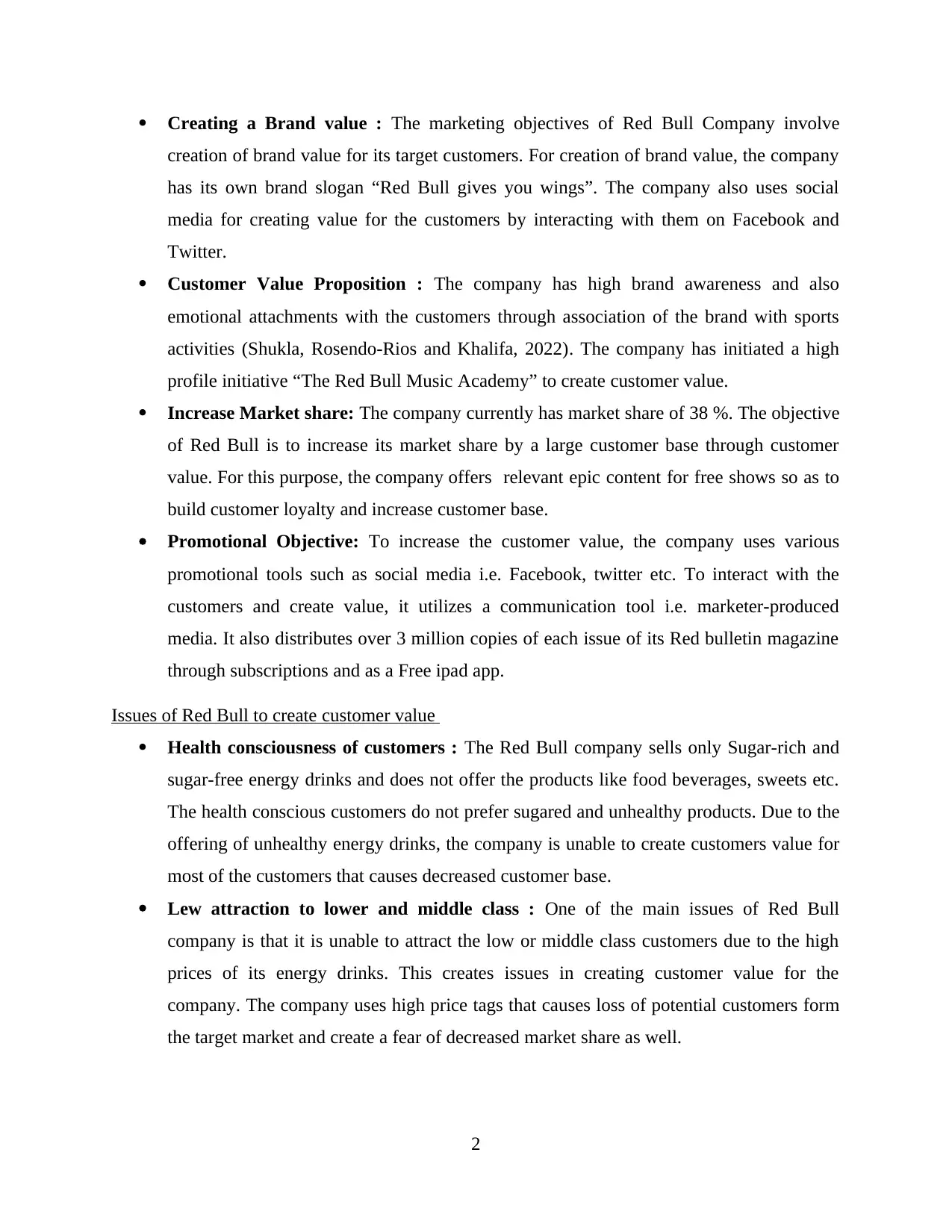
Creating a Brand value : The marketing objectives of Red Bull Company involve
creation of brand value for its target customers. For creation of brand value, the company
has its own brand slogan “Red Bull gives you wings”. The company also uses social
media for creating value for the customers by interacting with them on Facebook and
Twitter.
Customer Value Proposition : The company has high brand awareness and also
emotional attachments with the customers through association of the brand with sports
activities (Shukla, Rosendo-Rios and Khalifa, 2022). The company has initiated a high
profile initiative “The Red Bull Music Academy” to create customer value.
Increase Market share: The company currently has market share of 38 %. The objective
of Red Bull is to increase its market share by a large customer base through customer
value. For this purpose, the company offers relevant epic content for free shows so as to
build customer loyalty and increase customer base.
Promotional Objective: To increase the customer value, the company uses various
promotional tools such as social media i.e. Facebook, twitter etc. To interact with the
customers and create value, it utilizes a communication tool i.e. marketer-produced
media. It also distributes over 3 million copies of each issue of its Red bulletin magazine
through subscriptions and as a Free ipad app.
Issues of Red Bull to create customer value
Health consciousness of customers : The Red Bull company sells only Sugar-rich and
sugar-free energy drinks and does not offer the products like food beverages, sweets etc.
The health conscious customers do not prefer sugared and unhealthy products. Due to the
offering of unhealthy energy drinks, the company is unable to create customers value for
most of the customers that causes decreased customer base.
Lew attraction to lower and middle class : One of the main issues of Red Bull
company is that it is unable to attract the low or middle class customers due to the high
prices of its energy drinks. This creates issues in creating customer value for the
company. The company uses high price tags that causes loss of potential customers form
the target market and create a fear of decreased market share as well.
2
creation of brand value for its target customers. For creation of brand value, the company
has its own brand slogan “Red Bull gives you wings”. The company also uses social
media for creating value for the customers by interacting with them on Facebook and
Twitter.
Customer Value Proposition : The company has high brand awareness and also
emotional attachments with the customers through association of the brand with sports
activities (Shukla, Rosendo-Rios and Khalifa, 2022). The company has initiated a high
profile initiative “The Red Bull Music Academy” to create customer value.
Increase Market share: The company currently has market share of 38 %. The objective
of Red Bull is to increase its market share by a large customer base through customer
value. For this purpose, the company offers relevant epic content for free shows so as to
build customer loyalty and increase customer base.
Promotional Objective: To increase the customer value, the company uses various
promotional tools such as social media i.e. Facebook, twitter etc. To interact with the
customers and create value, it utilizes a communication tool i.e. marketer-produced
media. It also distributes over 3 million copies of each issue of its Red bulletin magazine
through subscriptions and as a Free ipad app.
Issues of Red Bull to create customer value
Health consciousness of customers : The Red Bull company sells only Sugar-rich and
sugar-free energy drinks and does not offer the products like food beverages, sweets etc.
The health conscious customers do not prefer sugared and unhealthy products. Due to the
offering of unhealthy energy drinks, the company is unable to create customers value for
most of the customers that causes decreased customer base.
Lew attraction to lower and middle class : One of the main issues of Red Bull
company is that it is unable to attract the low or middle class customers due to the high
prices of its energy drinks. This creates issues in creating customer value for the
company. The company uses high price tags that causes loss of potential customers form
the target market and create a fear of decreased market share as well.
2
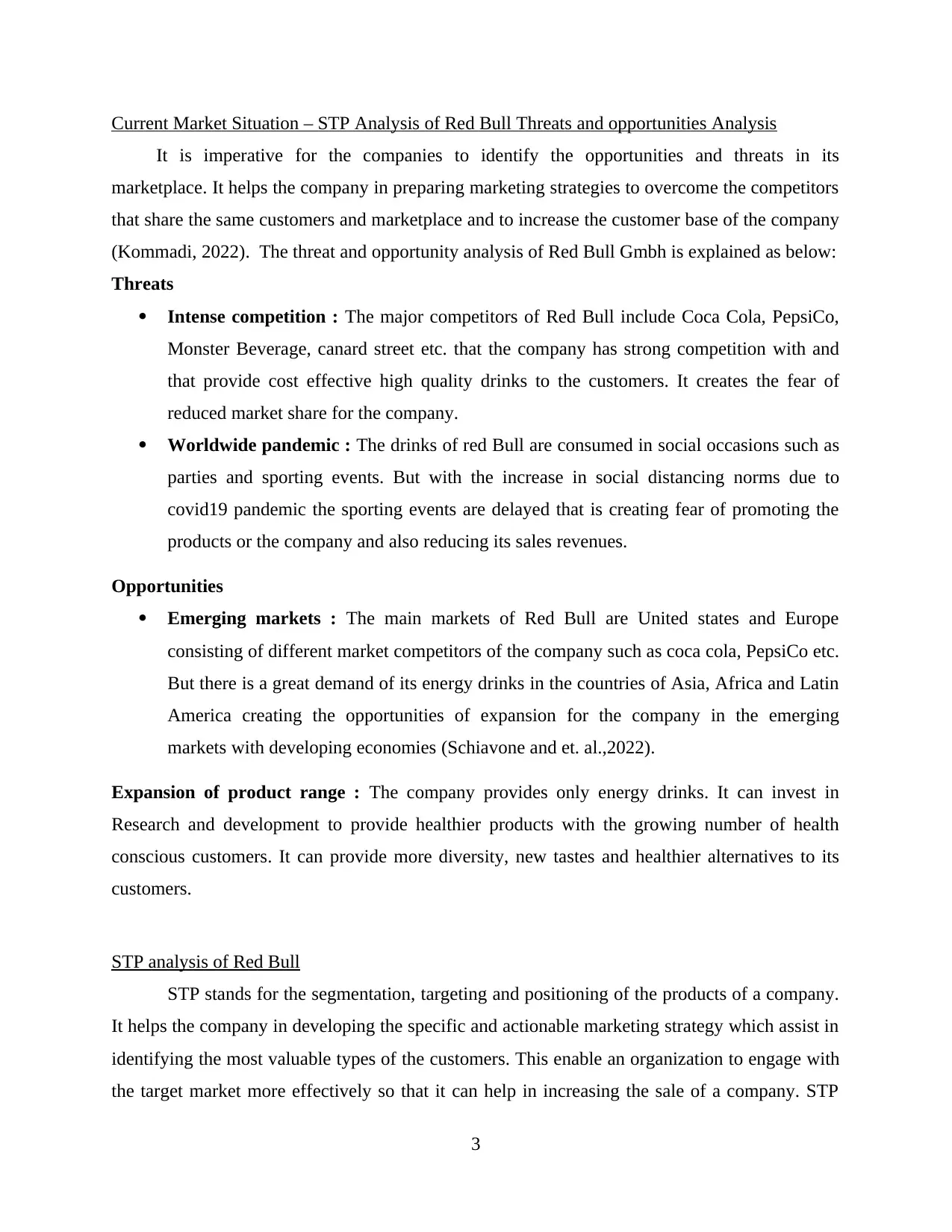
Current Market Situation – STP Analysis of Red Bull Threats and opportunities Analysis
It is imperative for the companies to identify the opportunities and threats in its
marketplace. It helps the company in preparing marketing strategies to overcome the competitors
that share the same customers and marketplace and to increase the customer base of the company
(Kommadi, 2022). The threat and opportunity analysis of Red Bull Gmbh is explained as below:
Threats
Intense competition : The major competitors of Red Bull include Coca Cola, PepsiCo,
Monster Beverage, canard street etc. that the company has strong competition with and
that provide cost effective high quality drinks to the customers. It creates the fear of
reduced market share for the company.
Worldwide pandemic : The drinks of red Bull are consumed in social occasions such as
parties and sporting events. But with the increase in social distancing norms due to
covid19 pandemic the sporting events are delayed that is creating fear of promoting the
products or the company and also reducing its sales revenues.
Opportunities
Emerging markets : The main markets of Red Bull are United states and Europe
consisting of different market competitors of the company such as coca cola, PepsiCo etc.
But there is a great demand of its energy drinks in the countries of Asia, Africa and Latin
America creating the opportunities of expansion for the company in the emerging
markets with developing economies (Schiavone and et. al.,2022).
Expansion of product range : The company provides only energy drinks. It can invest in
Research and development to provide healthier products with the growing number of health
conscious customers. It can provide more diversity, new tastes and healthier alternatives to its
customers.
STP analysis of Red Bull
STP stands for the segmentation, targeting and positioning of the products of a company.
It helps the company in developing the specific and actionable marketing strategy which assist in
identifying the most valuable types of the customers. This enable an organization to engage with
the target market more effectively so that it can help in increasing the sale of a company. STP
3
It is imperative for the companies to identify the opportunities and threats in its
marketplace. It helps the company in preparing marketing strategies to overcome the competitors
that share the same customers and marketplace and to increase the customer base of the company
(Kommadi, 2022). The threat and opportunity analysis of Red Bull Gmbh is explained as below:
Threats
Intense competition : The major competitors of Red Bull include Coca Cola, PepsiCo,
Monster Beverage, canard street etc. that the company has strong competition with and
that provide cost effective high quality drinks to the customers. It creates the fear of
reduced market share for the company.
Worldwide pandemic : The drinks of red Bull are consumed in social occasions such as
parties and sporting events. But with the increase in social distancing norms due to
covid19 pandemic the sporting events are delayed that is creating fear of promoting the
products or the company and also reducing its sales revenues.
Opportunities
Emerging markets : The main markets of Red Bull are United states and Europe
consisting of different market competitors of the company such as coca cola, PepsiCo etc.
But there is a great demand of its energy drinks in the countries of Asia, Africa and Latin
America creating the opportunities of expansion for the company in the emerging
markets with developing economies (Schiavone and et. al.,2022).
Expansion of product range : The company provides only energy drinks. It can invest in
Research and development to provide healthier products with the growing number of health
conscious customers. It can provide more diversity, new tastes and healthier alternatives to its
customers.
STP analysis of Red Bull
STP stands for the segmentation, targeting and positioning of the products of a company.
It helps the company in developing the specific and actionable marketing strategy which assist in
identifying the most valuable types of the customers. This enable an organization to engage with
the target market more effectively so that it can help in increasing the sale of a company. STP
3
⊘ This is a preview!⊘
Do you want full access?
Subscribe today to unlock all pages.

Trusted by 1+ million students worldwide
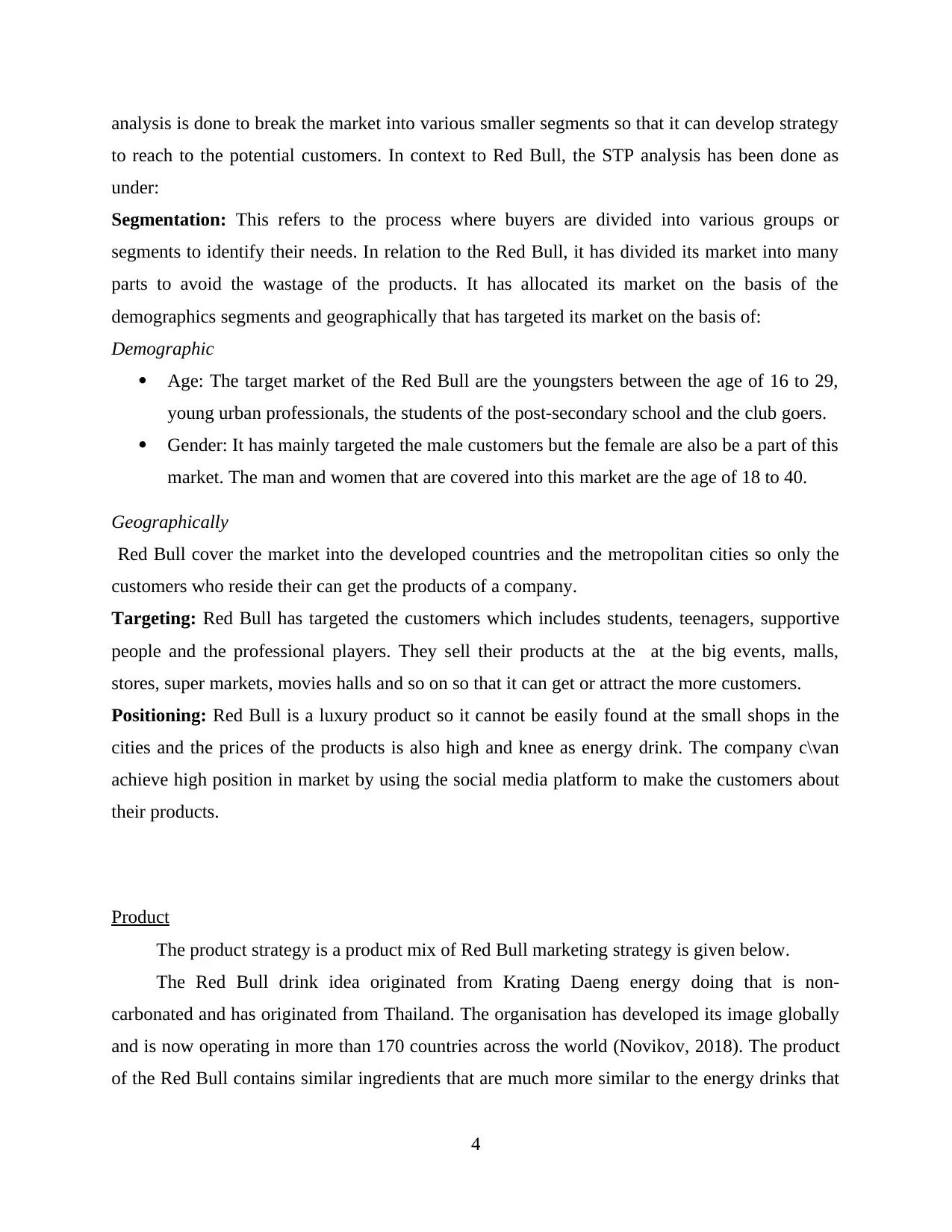
analysis is done to break the market into various smaller segments so that it can develop strategy
to reach to the potential customers. In context to Red Bull, the STP analysis has been done as
under:
Segmentation: This refers to the process where buyers are divided into various groups or
segments to identify their needs. In relation to the Red Bull, it has divided its market into many
parts to avoid the wastage of the products. It has allocated its market on the basis of the
demographics segments and geographically that has targeted its market on the basis of:
Demographic
Age: The target market of the Red Bull are the youngsters between the age of 16 to 29,
young urban professionals, the students of the post-secondary school and the club goers.
Gender: It has mainly targeted the male customers but the female are also be a part of this
market. The man and women that are covered into this market are the age of 18 to 40.
Geographically
Red Bull cover the market into the developed countries and the metropolitan cities so only the
customers who reside their can get the products of a company.
Targeting: Red Bull has targeted the customers which includes students, teenagers, supportive
people and the professional players. They sell their products at the at the big events, malls,
stores, super markets, movies halls and so on so that it can get or attract the more customers.
Positioning: Red Bull is a luxury product so it cannot be easily found at the small shops in the
cities and the prices of the products is also high and knee as energy drink. The company c\van
achieve high position in market by using the social media platform to make the customers about
their products.
Product
The product strategy is a product mix of Red Bull marketing strategy is given below.
The Red Bull drink idea originated from Krating Daeng energy doing that is non-
carbonated and has originated from Thailand. The organisation has developed its image globally
and is now operating in more than 170 countries across the world (Novikov, 2018). The product
of the Red Bull contains similar ingredients that are much more similar to the energy drinks that
4
to reach to the potential customers. In context to Red Bull, the STP analysis has been done as
under:
Segmentation: This refers to the process where buyers are divided into various groups or
segments to identify their needs. In relation to the Red Bull, it has divided its market into many
parts to avoid the wastage of the products. It has allocated its market on the basis of the
demographics segments and geographically that has targeted its market on the basis of:
Demographic
Age: The target market of the Red Bull are the youngsters between the age of 16 to 29,
young urban professionals, the students of the post-secondary school and the club goers.
Gender: It has mainly targeted the male customers but the female are also be a part of this
market. The man and women that are covered into this market are the age of 18 to 40.
Geographically
Red Bull cover the market into the developed countries and the metropolitan cities so only the
customers who reside their can get the products of a company.
Targeting: Red Bull has targeted the customers which includes students, teenagers, supportive
people and the professional players. They sell their products at the at the big events, malls,
stores, super markets, movies halls and so on so that it can get or attract the more customers.
Positioning: Red Bull is a luxury product so it cannot be easily found at the small shops in the
cities and the prices of the products is also high and knee as energy drink. The company c\van
achieve high position in market by using the social media platform to make the customers about
their products.
Product
The product strategy is a product mix of Red Bull marketing strategy is given below.
The Red Bull drink idea originated from Krating Daeng energy doing that is non-
carbonated and has originated from Thailand. The organisation has developed its image globally
and is now operating in more than 170 countries across the world (Novikov, 2018). The product
of the Red Bull contains similar ingredients that are much more similar to the energy drinks that
4
Paraphrase This Document
Need a fresh take? Get an instant paraphrase of this document with our AI Paraphraser
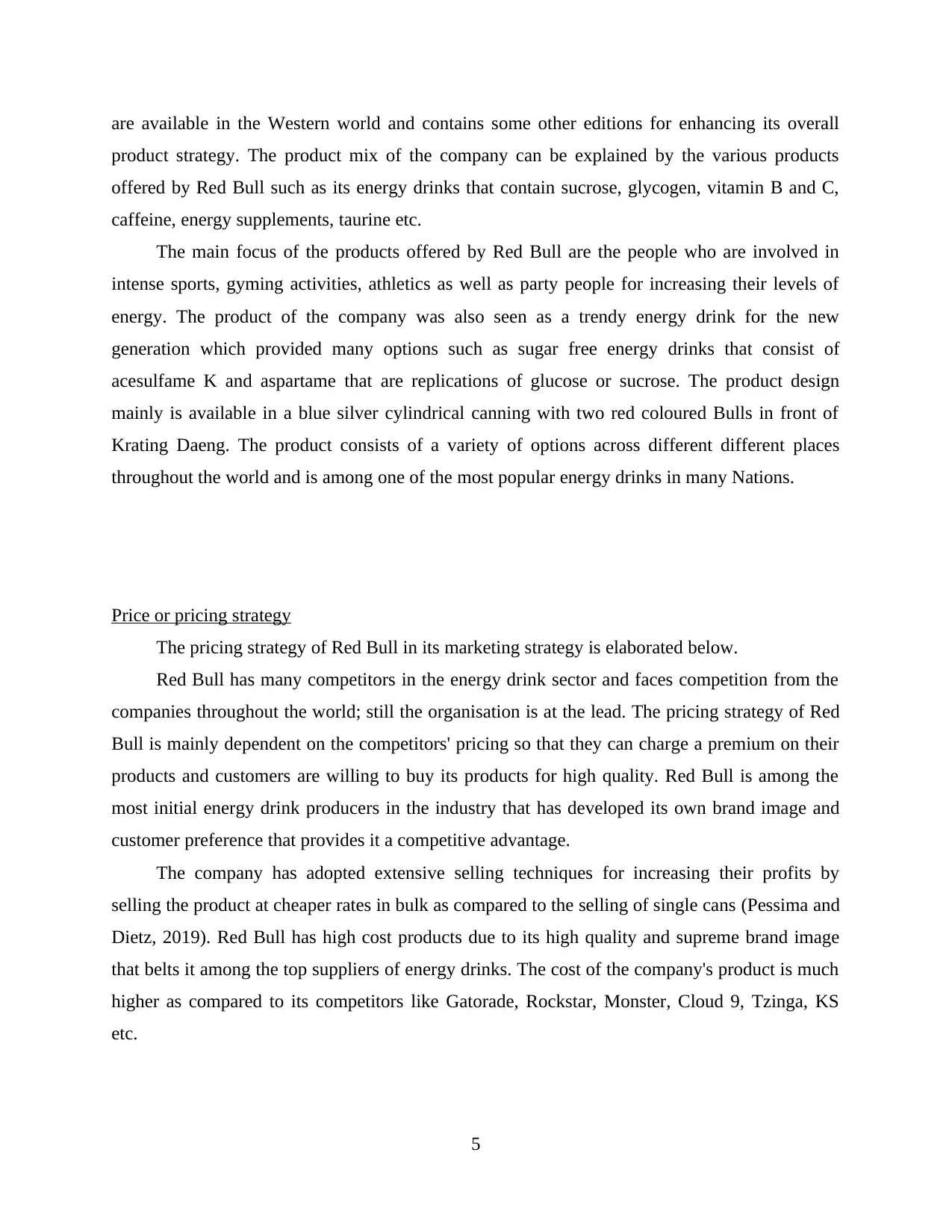
are available in the Western world and contains some other editions for enhancing its overall
product strategy. The product mix of the company can be explained by the various products
offered by Red Bull such as its energy drinks that contain sucrose, glycogen, vitamin B and C,
caffeine, energy supplements, taurine etc.
The main focus of the products offered by Red Bull are the people who are involved in
intense sports, gyming activities, athletics as well as party people for increasing their levels of
energy. The product of the company was also seen as a trendy energy drink for the new
generation which provided many options such as sugar free energy drinks that consist of
acesulfame K and aspartame that are replications of glucose or sucrose. The product design
mainly is available in a blue silver cylindrical canning with two red coloured Bulls in front of
Krating Daeng. The product consists of a variety of options across different different places
throughout the world and is among one of the most popular energy drinks in many Nations.
Price or pricing strategy
The pricing strategy of Red Bull in its marketing strategy is elaborated below.
Red Bull has many competitors in the energy drink sector and faces competition from the
companies throughout the world; still the organisation is at the lead. The pricing strategy of Red
Bull is mainly dependent on the competitors' pricing so that they can charge a premium on their
products and customers are willing to buy its products for high quality. Red Bull is among the
most initial energy drink producers in the industry that has developed its own brand image and
customer preference that provides it a competitive advantage.
The company has adopted extensive selling techniques for increasing their profits by
selling the product at cheaper rates in bulk as compared to the selling of single cans (Pessima and
Dietz, 2019). Red Bull has high cost products due to its high quality and supreme brand image
that belts it among the top suppliers of energy drinks. The cost of the company's product is much
higher as compared to its competitors like Gatorade, Rockstar, Monster, Cloud 9, Tzinga, KS
etc.
5
product strategy. The product mix of the company can be explained by the various products
offered by Red Bull such as its energy drinks that contain sucrose, glycogen, vitamin B and C,
caffeine, energy supplements, taurine etc.
The main focus of the products offered by Red Bull are the people who are involved in
intense sports, gyming activities, athletics as well as party people for increasing their levels of
energy. The product of the company was also seen as a trendy energy drink for the new
generation which provided many options such as sugar free energy drinks that consist of
acesulfame K and aspartame that are replications of glucose or sucrose. The product design
mainly is available in a blue silver cylindrical canning with two red coloured Bulls in front of
Krating Daeng. The product consists of a variety of options across different different places
throughout the world and is among one of the most popular energy drinks in many Nations.
Price or pricing strategy
The pricing strategy of Red Bull in its marketing strategy is elaborated below.
Red Bull has many competitors in the energy drink sector and faces competition from the
companies throughout the world; still the organisation is at the lead. The pricing strategy of Red
Bull is mainly dependent on the competitors' pricing so that they can charge a premium on their
products and customers are willing to buy its products for high quality. Red Bull is among the
most initial energy drink producers in the industry that has developed its own brand image and
customer preference that provides it a competitive advantage.
The company has adopted extensive selling techniques for increasing their profits by
selling the product at cheaper rates in bulk as compared to the selling of single cans (Pessima and
Dietz, 2019). Red Bull has high cost products due to its high quality and supreme brand image
that belts it among the top suppliers of energy drinks. The cost of the company's product is much
higher as compared to its competitors like Gatorade, Rockstar, Monster, Cloud 9, Tzinga, KS
etc.
5
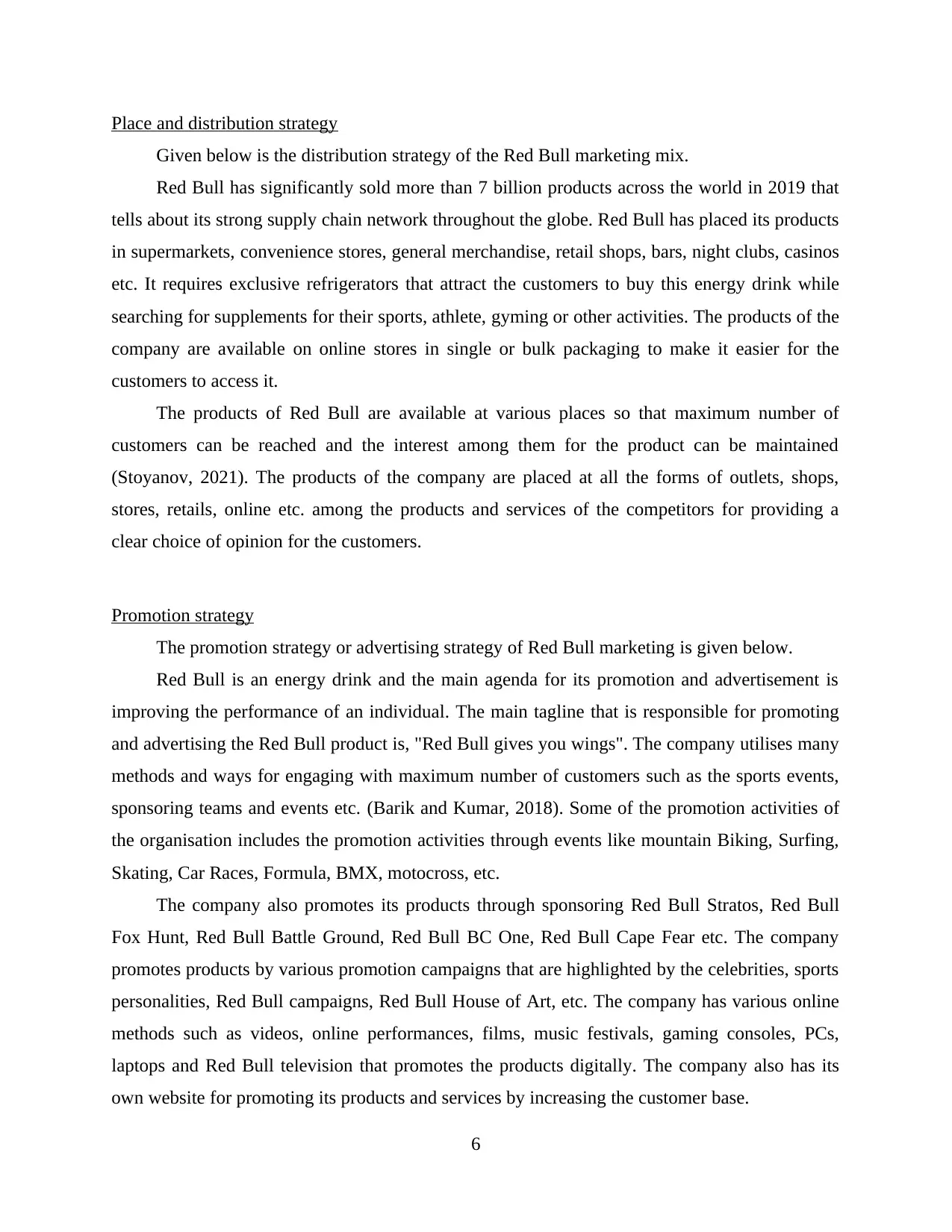
Place and distribution strategy
Given below is the distribution strategy of the Red Bull marketing mix.
Red Bull has significantly sold more than 7 billion products across the world in 2019 that
tells about its strong supply chain network throughout the globe. Red Bull has placed its products
in supermarkets, convenience stores, general merchandise, retail shops, bars, night clubs, casinos
etc. It requires exclusive refrigerators that attract the customers to buy this energy drink while
searching for supplements for their sports, athlete, gyming or other activities. The products of the
company are available on online stores in single or bulk packaging to make it easier for the
customers to access it.
The products of Red Bull are available at various places so that maximum number of
customers can be reached and the interest among them for the product can be maintained
(Stoyanov, 2021). The products of the company are placed at all the forms of outlets, shops,
stores, retails, online etc. among the products and services of the competitors for providing a
clear choice of opinion for the customers.
Promotion strategy
The promotion strategy or advertising strategy of Red Bull marketing is given below.
Red Bull is an energy drink and the main agenda for its promotion and advertisement is
improving the performance of an individual. The main tagline that is responsible for promoting
and advertising the Red Bull product is, "Red Bull gives you wings". The company utilises many
methods and ways for engaging with maximum number of customers such as the sports events,
sponsoring teams and events etc. (Barik and Kumar, 2018). Some of the promotion activities of
the organisation includes the promotion activities through events like mountain Biking, Surfing,
Skating, Car Races, Formula, BMX, motocross, etc.
The company also promotes its products through sponsoring Red Bull Stratos, Red Bull
Fox Hunt, Red Bull Battle Ground, Red Bull BC One, Red Bull Cape Fear etc. The company
promotes products by various promotion campaigns that are highlighted by the celebrities, sports
personalities, Red Bull campaigns, Red Bull House of Art, etc. The company has various online
methods such as videos, online performances, films, music festivals, gaming consoles, PCs,
laptops and Red Bull television that promotes the products digitally. The company also has its
own website for promoting its products and services by increasing the customer base.
6
Given below is the distribution strategy of the Red Bull marketing mix.
Red Bull has significantly sold more than 7 billion products across the world in 2019 that
tells about its strong supply chain network throughout the globe. Red Bull has placed its products
in supermarkets, convenience stores, general merchandise, retail shops, bars, night clubs, casinos
etc. It requires exclusive refrigerators that attract the customers to buy this energy drink while
searching for supplements for their sports, athlete, gyming or other activities. The products of the
company are available on online stores in single or bulk packaging to make it easier for the
customers to access it.
The products of Red Bull are available at various places so that maximum number of
customers can be reached and the interest among them for the product can be maintained
(Stoyanov, 2021). The products of the company are placed at all the forms of outlets, shops,
stores, retails, online etc. among the products and services of the competitors for providing a
clear choice of opinion for the customers.
Promotion strategy
The promotion strategy or advertising strategy of Red Bull marketing is given below.
Red Bull is an energy drink and the main agenda for its promotion and advertisement is
improving the performance of an individual. The main tagline that is responsible for promoting
and advertising the Red Bull product is, "Red Bull gives you wings". The company utilises many
methods and ways for engaging with maximum number of customers such as the sports events,
sponsoring teams and events etc. (Barik and Kumar, 2018). Some of the promotion activities of
the organisation includes the promotion activities through events like mountain Biking, Surfing,
Skating, Car Races, Formula, BMX, motocross, etc.
The company also promotes its products through sponsoring Red Bull Stratos, Red Bull
Fox Hunt, Red Bull Battle Ground, Red Bull BC One, Red Bull Cape Fear etc. The company
promotes products by various promotion campaigns that are highlighted by the celebrities, sports
personalities, Red Bull campaigns, Red Bull House of Art, etc. The company has various online
methods such as videos, online performances, films, music festivals, gaming consoles, PCs,
laptops and Red Bull television that promotes the products digitally. The company also has its
own website for promoting its products and services by increasing the customer base.
6
⊘ This is a preview!⊘
Do you want full access?
Subscribe today to unlock all pages.

Trusted by 1+ million students worldwide
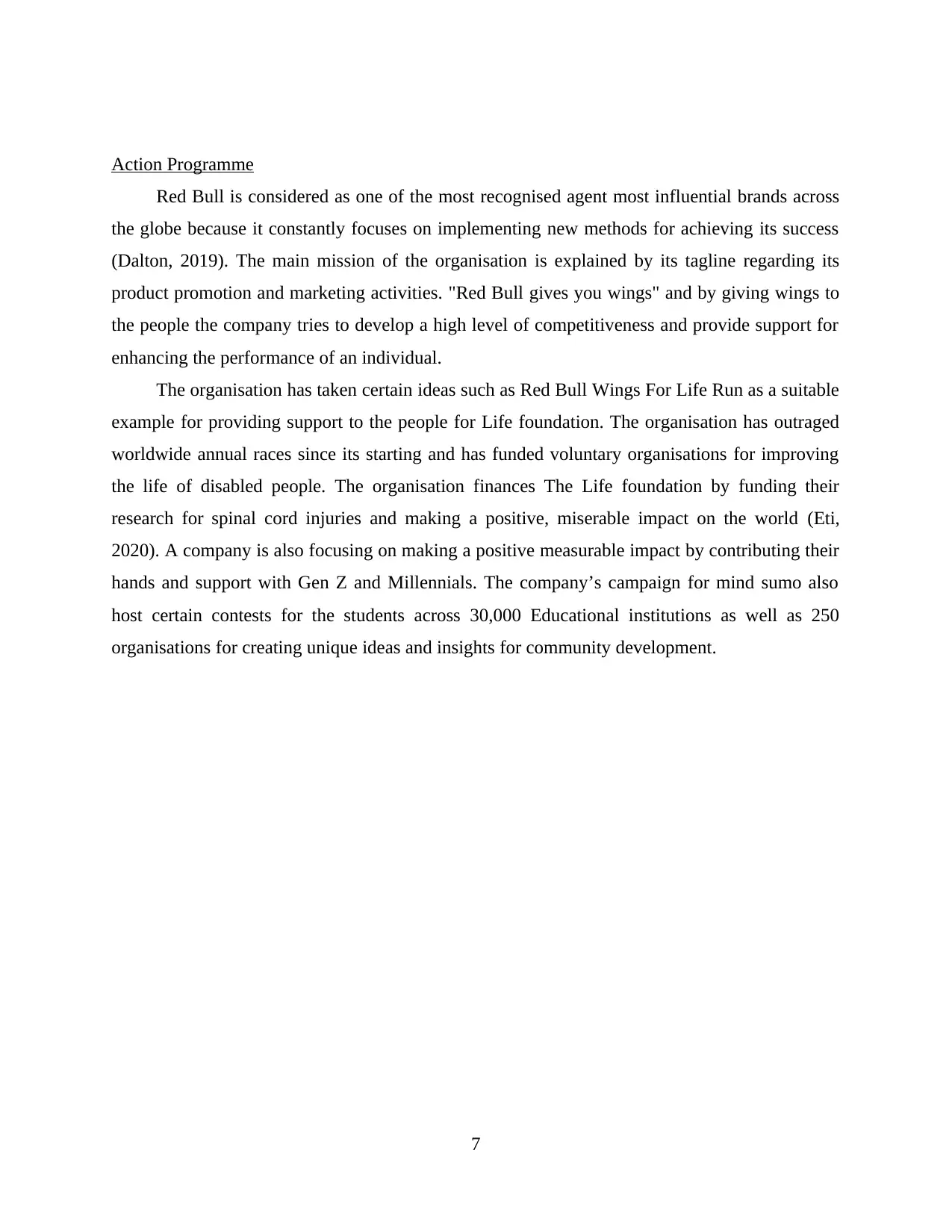
Action Programme
Red Bull is considered as one of the most recognised agent most influential brands across
the globe because it constantly focuses on implementing new methods for achieving its success
(Dalton, 2019). The main mission of the organisation is explained by its tagline regarding its
product promotion and marketing activities. "Red Bull gives you wings" and by giving wings to
the people the company tries to develop a high level of competitiveness and provide support for
enhancing the performance of an individual.
The organisation has taken certain ideas such as Red Bull Wings For Life Run as a suitable
example for providing support to the people for Life foundation. The organisation has outraged
worldwide annual races since its starting and has funded voluntary organisations for improving
the life of disabled people. The organisation finances The Life foundation by funding their
research for spinal cord injuries and making a positive, miserable impact on the world (Eti,
2020). A company is also focusing on making a positive measurable impact by contributing their
hands and support with Gen Z and Millennials. The company’s campaign for mind sumo also
host certain contests for the students across 30,000 Educational institutions as well as 250
organisations for creating unique ideas and insights for community development.
7
Red Bull is considered as one of the most recognised agent most influential brands across
the globe because it constantly focuses on implementing new methods for achieving its success
(Dalton, 2019). The main mission of the organisation is explained by its tagline regarding its
product promotion and marketing activities. "Red Bull gives you wings" and by giving wings to
the people the company tries to develop a high level of competitiveness and provide support for
enhancing the performance of an individual.
The organisation has taken certain ideas such as Red Bull Wings For Life Run as a suitable
example for providing support to the people for Life foundation. The organisation has outraged
worldwide annual races since its starting and has funded voluntary organisations for improving
the life of disabled people. The organisation finances The Life foundation by funding their
research for spinal cord injuries and making a positive, miserable impact on the world (Eti,
2020). A company is also focusing on making a positive measurable impact by contributing their
hands and support with Gen Z and Millennials. The company’s campaign for mind sumo also
host certain contests for the students across 30,000 Educational institutions as well as 250
organisations for creating unique ideas and insights for community development.
7
Paraphrase This Document
Need a fresh take? Get an instant paraphrase of this document with our AI Paraphraser
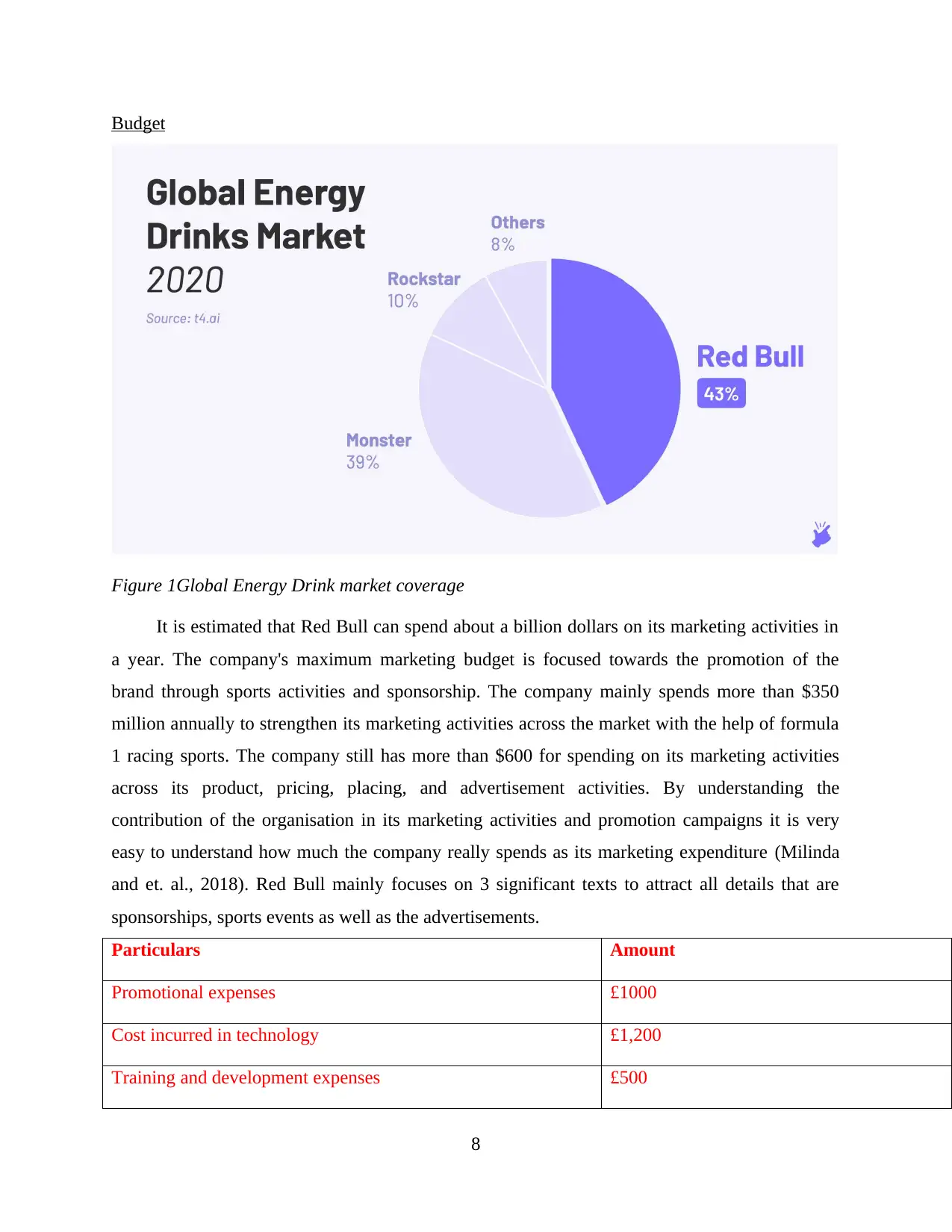
Budget
Figure 1Global Energy Drink market coverage
It is estimated that Red Bull can spend about a billion dollars on its marketing activities in
a year. The company's maximum marketing budget is focused towards the promotion of the
brand through sports activities and sponsorship. The company mainly spends more than $350
million annually to strengthen its marketing activities across the market with the help of formula
1 racing sports. The company still has more than $600 for spending on its marketing activities
across its product, pricing, placing, and advertisement activities. By understanding the
contribution of the organisation in its marketing activities and promotion campaigns it is very
easy to understand how much the company really spends as its marketing expenditure (Milinda
and et. al., 2018). Red Bull mainly focuses on 3 significant texts to attract all details that are
sponsorships, sports events as well as the advertisements.
Particulars Amount
Promotional expenses £1000
Cost incurred in technology £1,200
Training and development expenses £500
8
Figure 1Global Energy Drink market coverage
It is estimated that Red Bull can spend about a billion dollars on its marketing activities in
a year. The company's maximum marketing budget is focused towards the promotion of the
brand through sports activities and sponsorship. The company mainly spends more than $350
million annually to strengthen its marketing activities across the market with the help of formula
1 racing sports. The company still has more than $600 for spending on its marketing activities
across its product, pricing, placing, and advertisement activities. By understanding the
contribution of the organisation in its marketing activities and promotion campaigns it is very
easy to understand how much the company really spends as its marketing expenditure (Milinda
and et. al., 2018). Red Bull mainly focuses on 3 significant texts to attract all details that are
sponsorships, sports events as well as the advertisements.
Particulars Amount
Promotional expenses £1000
Cost incurred in technology £1,200
Training and development expenses £500
8
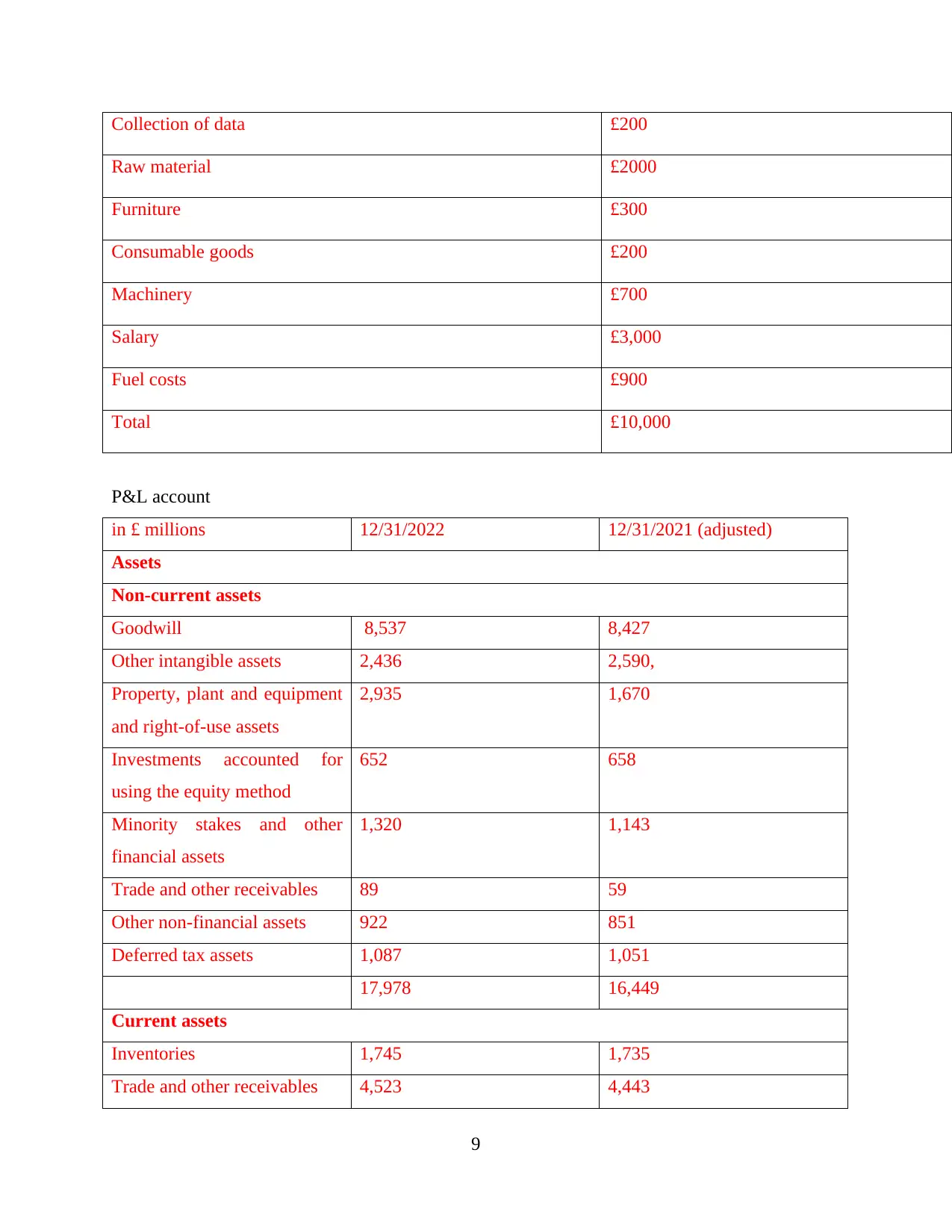
Collection of data £200
Raw material £2000
Furniture £300
Consumable goods £200
Machinery £700
Salary £3,000
Fuel costs £900
Total £10,000
P&L account
in £ millions 12/31/2022 12/31/2021 (adjusted)
Assets
Non-current assets
Goodwill 8,537 8,427
Other intangible assets 2,436 2,590,
Property, plant and equipment
and right-of-use assets
2,935 1,670
Investments accounted for
using the equity method
652 658
Minority stakes and other
financial assets
1,320 1,143
Trade and other receivables 89 59
Other non-financial assets 922 851
Deferred tax assets 1,087 1,051
17,978 16,449
Current assets
Inventories 1,745 1,735
Trade and other receivables 4,523 4,443
9
Raw material £2000
Furniture £300
Consumable goods £200
Machinery £700
Salary £3,000
Fuel costs £900
Total £10,000
P&L account
in £ millions 12/31/2022 12/31/2021 (adjusted)
Assets
Non-current assets
Goodwill 8,537 8,427
Other intangible assets 2,436 2,590,
Property, plant and equipment
and right-of-use assets
2,935 1,670
Investments accounted for
using the equity method
652 658
Minority stakes and other
financial assets
1,320 1,143
Trade and other receivables 89 59
Other non-financial assets 922 851
Deferred tax assets 1,087 1,051
17,978 16,449
Current assets
Inventories 1,745 1,735
Trade and other receivables 4,523 4,443
9
⊘ This is a preview!⊘
Do you want full access?
Subscribe today to unlock all pages.

Trusted by 1+ million students worldwide
1 out of 19
Related Documents
Your All-in-One AI-Powered Toolkit for Academic Success.
+13062052269
info@desklib.com
Available 24*7 on WhatsApp / Email
![[object Object]](/_next/static/media/star-bottom.7253800d.svg)
Unlock your academic potential
Copyright © 2020–2025 A2Z Services. All Rights Reserved. Developed and managed by ZUCOL.





